Accounting and Finance Report: University of Derby, Accounting Module
VerifiedAdded on 2023/01/10
|10
|2560
|52
Report
AI Summary
This report provides a comprehensive analysis of accounting and finance principles, addressing key aspects of financial management and control. Part 1 focuses on the preparation of profit and loss statements for different divisions, highlighting the impact of transfer pricing policies and potential profit enhancements through increased production capacity. It includes calculations related to retail sales and the implications of shifting transfer pricing from cost-plus to opportunity cost. Part 2 critically evaluates the use of capital controls in the banking industry, examining arguments for and against their implementation, particularly in the context of the 2007-2008 global financial crisis. The report explores the benefits of capital controls in maintaining economic stability and managing exchange rate volatility, while also acknowledging the potential downsides, such as market inefficiencies and difficulties in enforcement. The study draws upon the case of Iceland and the United Kingdom, to illustrate the impacts of capital controls on the banking sector and the broader economy.
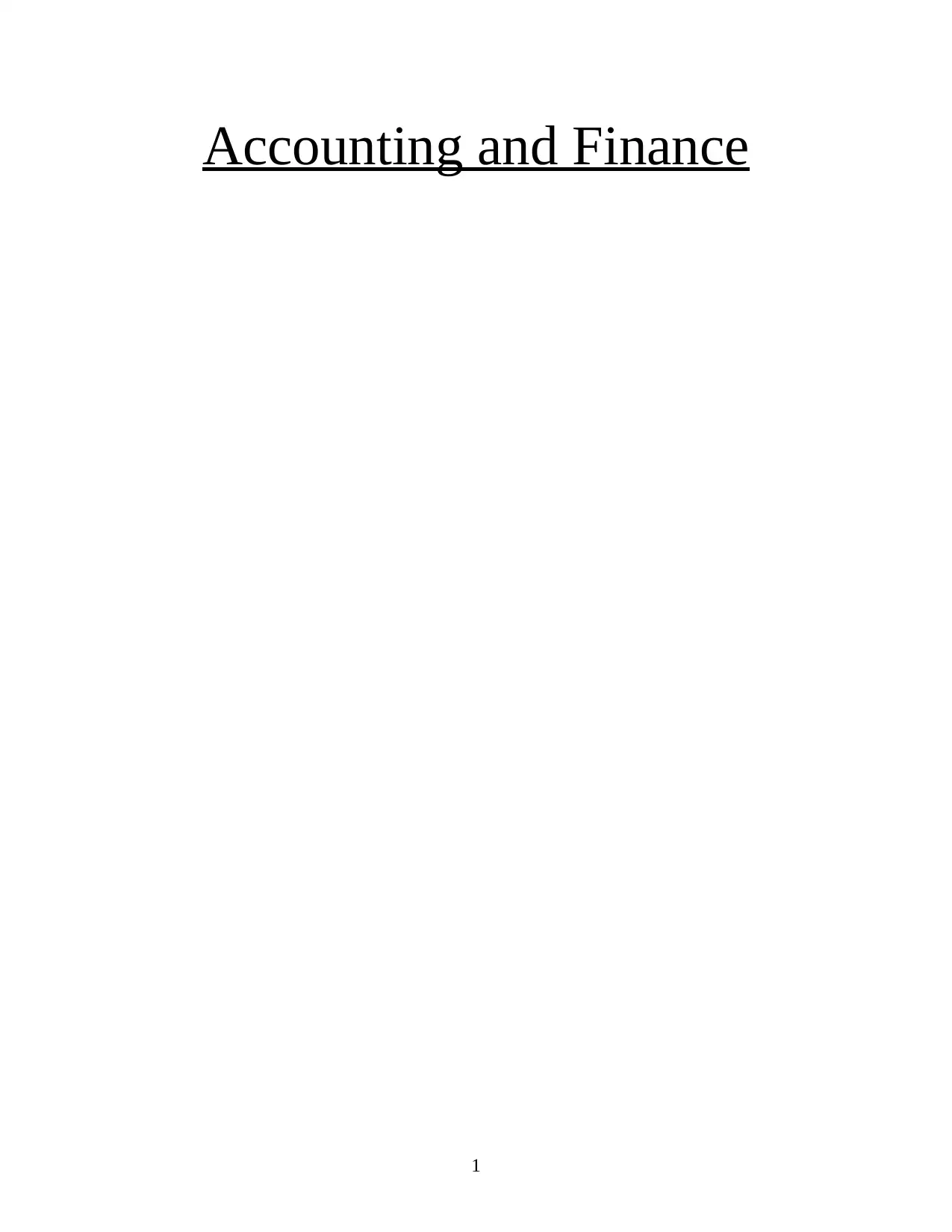
Accounting and Finance
1
1
Paraphrase This Document
Need a fresh take? Get an instant paraphrase of this document with our AI Paraphraser
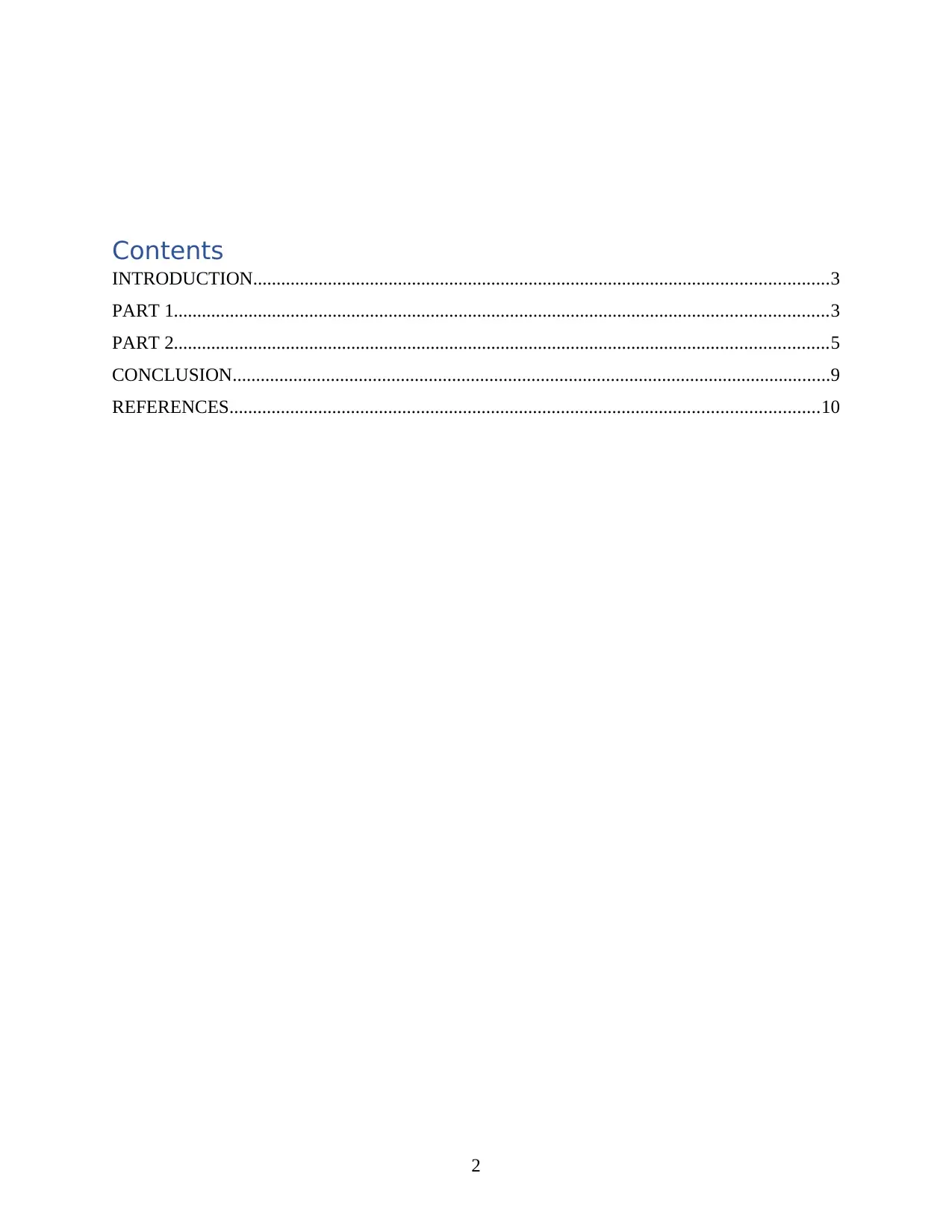
Contents
INTRODUCTION...........................................................................................................................3
PART 1............................................................................................................................................3
PART 2............................................................................................................................................5
CONCLUSION................................................................................................................................9
REFERENCES..............................................................................................................................10
2
INTRODUCTION...........................................................................................................................3
PART 1............................................................................................................................................3
PART 2............................................................................................................................................5
CONCLUSION................................................................................................................................9
REFERENCES..............................................................................................................................10
2
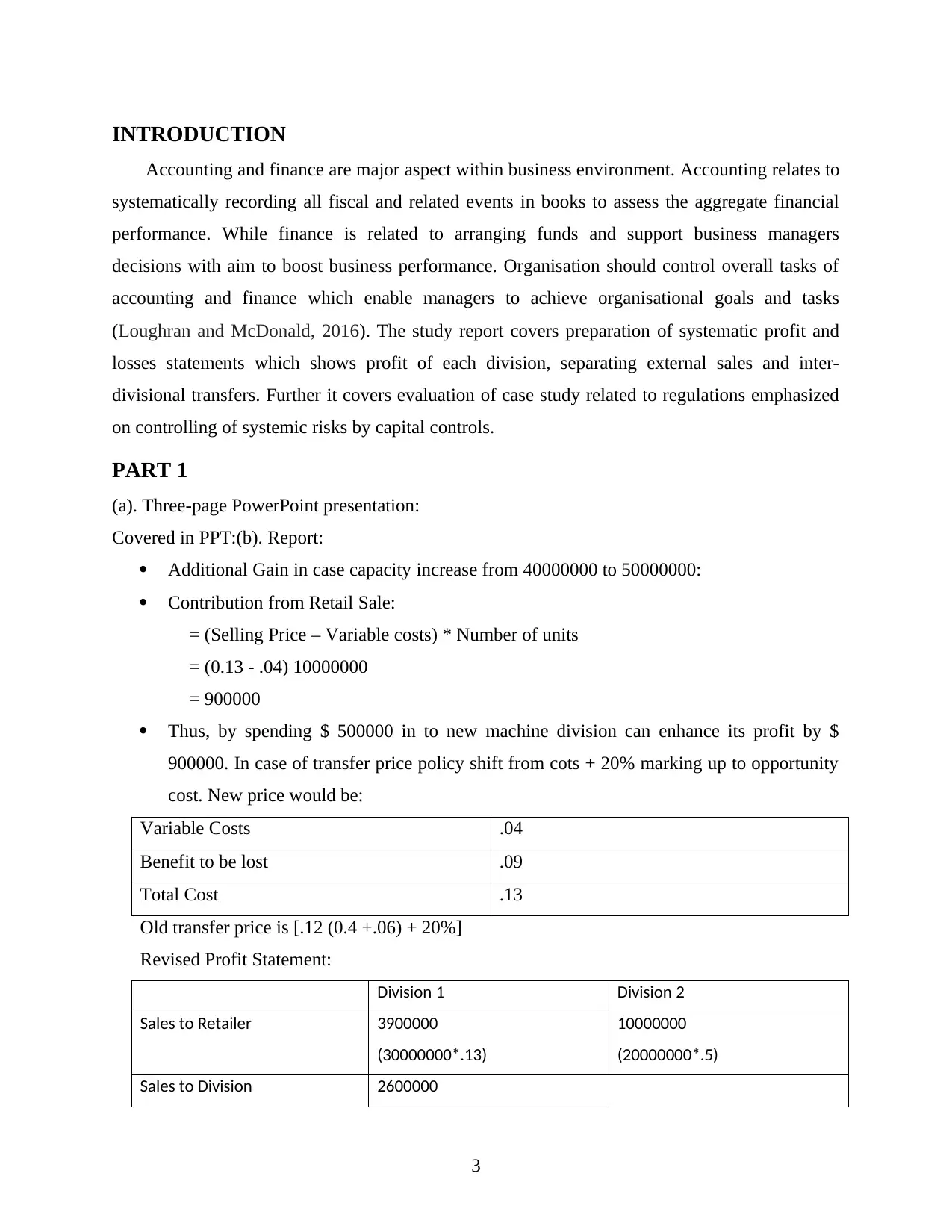
INTRODUCTION
Accounting and finance are major aspect within business environment. Accounting relates to
systematically recording all fiscal and related events in books to assess the aggregate financial
performance. While finance is related to arranging funds and support business managers
decisions with aim to boost business performance. Organisation should control overall tasks of
accounting and finance which enable managers to achieve organisational goals and tasks
(Loughran and McDonald, 2016). The study report covers preparation of systematic profit and
losses statements which shows profit of each division, separating external sales and inter-
divisional transfers. Further it covers evaluation of case study related to regulations emphasized
on controlling of systemic risks by capital controls.
PART 1
(a). Three-page PowerPoint presentation:
Covered in PPT:(b). Report:
Additional Gain in case capacity increase from 40000000 to 50000000:
Contribution from Retail Sale:
= (Selling Price – Variable costs) * Number of units
= (0.13 - .04) 10000000
= 900000
Thus, by spending $ 500000 in to new machine division can enhance its profit by $
900000. In case of transfer price policy shift from cots + 20% marking up to opportunity
cost. New price would be:
Variable Costs .04
Benefit to be lost .09
Total Cost .13
Old transfer price is [.12 (0.4 +.06) + 20%]
Revised Profit Statement:
Division 1 Division 2
Sales to Retailer 3900000
(30000000*.13)
10000000
(20000000*.5)
Sales to Division 2600000
3
Accounting and finance are major aspect within business environment. Accounting relates to
systematically recording all fiscal and related events in books to assess the aggregate financial
performance. While finance is related to arranging funds and support business managers
decisions with aim to boost business performance. Organisation should control overall tasks of
accounting and finance which enable managers to achieve organisational goals and tasks
(Loughran and McDonald, 2016). The study report covers preparation of systematic profit and
losses statements which shows profit of each division, separating external sales and inter-
divisional transfers. Further it covers evaluation of case study related to regulations emphasized
on controlling of systemic risks by capital controls.
PART 1
(a). Three-page PowerPoint presentation:
Covered in PPT:(b). Report:
Additional Gain in case capacity increase from 40000000 to 50000000:
Contribution from Retail Sale:
= (Selling Price – Variable costs) * Number of units
= (0.13 - .04) 10000000
= 900000
Thus, by spending $ 500000 in to new machine division can enhance its profit by $
900000. In case of transfer price policy shift from cots + 20% marking up to opportunity
cost. New price would be:
Variable Costs .04
Benefit to be lost .09
Total Cost .13
Old transfer price is [.12 (0.4 +.06) + 20%]
Revised Profit Statement:
Division 1 Division 2
Sales to Retailer 3900000
(30000000*.13)
10000000
(20000000*.5)
Sales to Division 2600000
3
⊘ This is a preview!⊘
Do you want full access?
Subscribe today to unlock all pages.

Trusted by 1+ million students worldwide
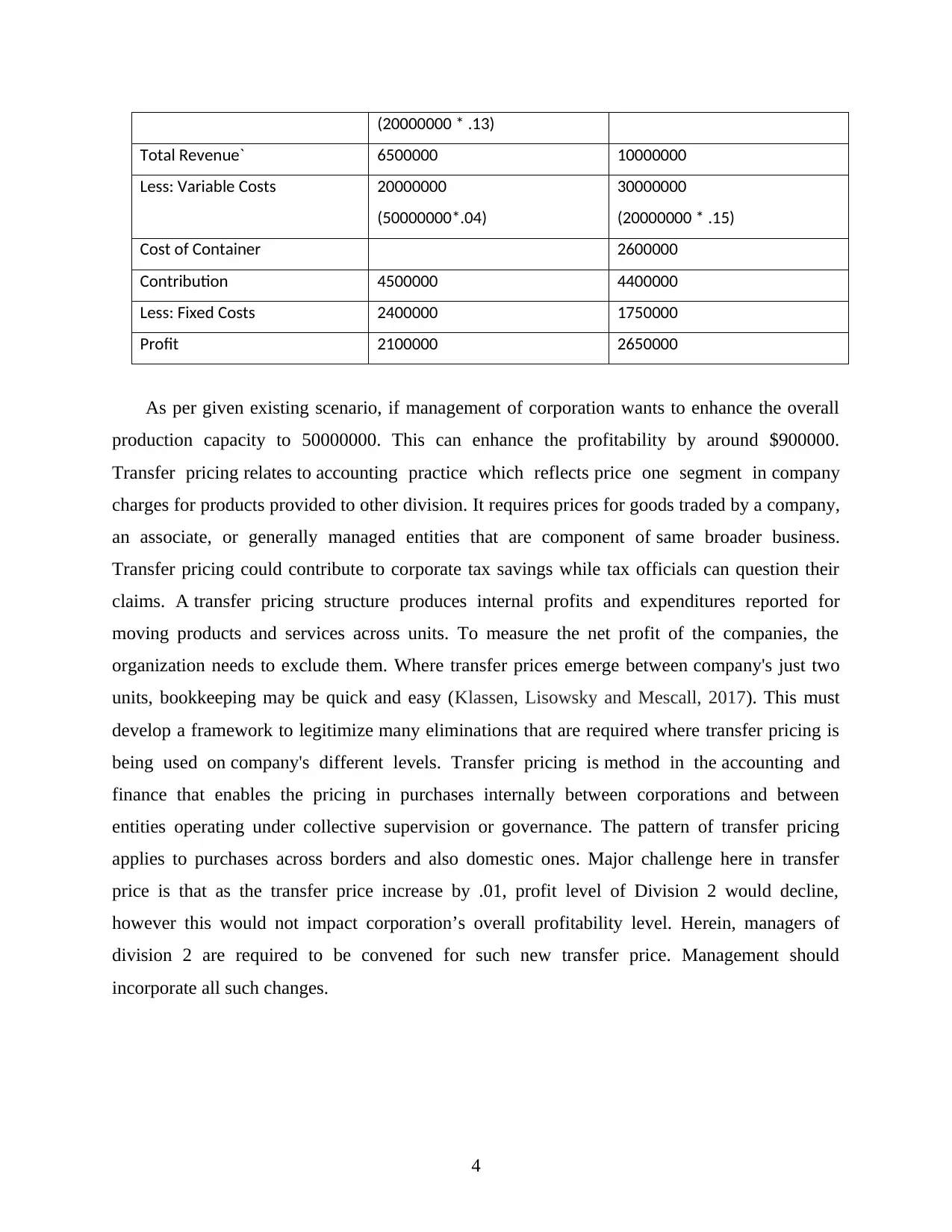
(20000000 * .13)
Total Revenue` 6500000 10000000
Less: Variable Costs 20000000
(50000000*.04)
30000000
(20000000 * .15)
Cost of Container 2600000
Contribution 4500000 4400000
Less: Fixed Costs 2400000 1750000
Profit 2100000 2650000
As per given existing scenario, if management of corporation wants to enhance the overall
production capacity to 50000000. This can enhance the profitability by around $900000.
Transfer pricing relates to accounting practice which reflects price one segment in company
charges for products provided to other division. It requires prices for goods traded by a company,
an associate, or generally managed entities that are component of same broader business.
Transfer pricing could contribute to corporate tax savings while tax officials can question their
claims. A transfer pricing structure produces internal profits and expenditures reported for
moving products and services across units. To measure the net profit of the companies, the
organization needs to exclude them. Where transfer prices emerge between company's just two
units, bookkeeping may be quick and easy (Klassen, Lisowsky and Mescall, 2017). This must
develop a framework to legitimize many eliminations that are required where transfer pricing is
being used on company's different levels. Transfer pricing is method in the accounting and
finance that enables the pricing in purchases internally between corporations and between
entities operating under collective supervision or governance. The pattern of transfer pricing
applies to purchases across borders and also domestic ones. Major challenge here in transfer
price is that as the transfer price increase by .01, profit level of Division 2 would decline,
however this would not impact corporation’s overall profitability level. Herein, managers of
division 2 are required to be convened for such new transfer price. Management should
incorporate all such changes.
4
Total Revenue` 6500000 10000000
Less: Variable Costs 20000000
(50000000*.04)
30000000
(20000000 * .15)
Cost of Container 2600000
Contribution 4500000 4400000
Less: Fixed Costs 2400000 1750000
Profit 2100000 2650000
As per given existing scenario, if management of corporation wants to enhance the overall
production capacity to 50000000. This can enhance the profitability by around $900000.
Transfer pricing relates to accounting practice which reflects price one segment in company
charges for products provided to other division. It requires prices for goods traded by a company,
an associate, or generally managed entities that are component of same broader business.
Transfer pricing could contribute to corporate tax savings while tax officials can question their
claims. A transfer pricing structure produces internal profits and expenditures reported for
moving products and services across units. To measure the net profit of the companies, the
organization needs to exclude them. Where transfer prices emerge between company's just two
units, bookkeeping may be quick and easy (Klassen, Lisowsky and Mescall, 2017). This must
develop a framework to legitimize many eliminations that are required where transfer pricing is
being used on company's different levels. Transfer pricing is method in the accounting and
finance that enables the pricing in purchases internally between corporations and between
entities operating under collective supervision or governance. The pattern of transfer pricing
applies to purchases across borders and also domestic ones. Major challenge here in transfer
price is that as the transfer price increase by .01, profit level of Division 2 would decline,
however this would not impact corporation’s overall profitability level. Herein, managers of
division 2 are required to be convened for such new transfer price. Management should
incorporate all such changes.
4
Paraphrase This Document
Need a fresh take? Get an instant paraphrase of this document with our AI Paraphraser
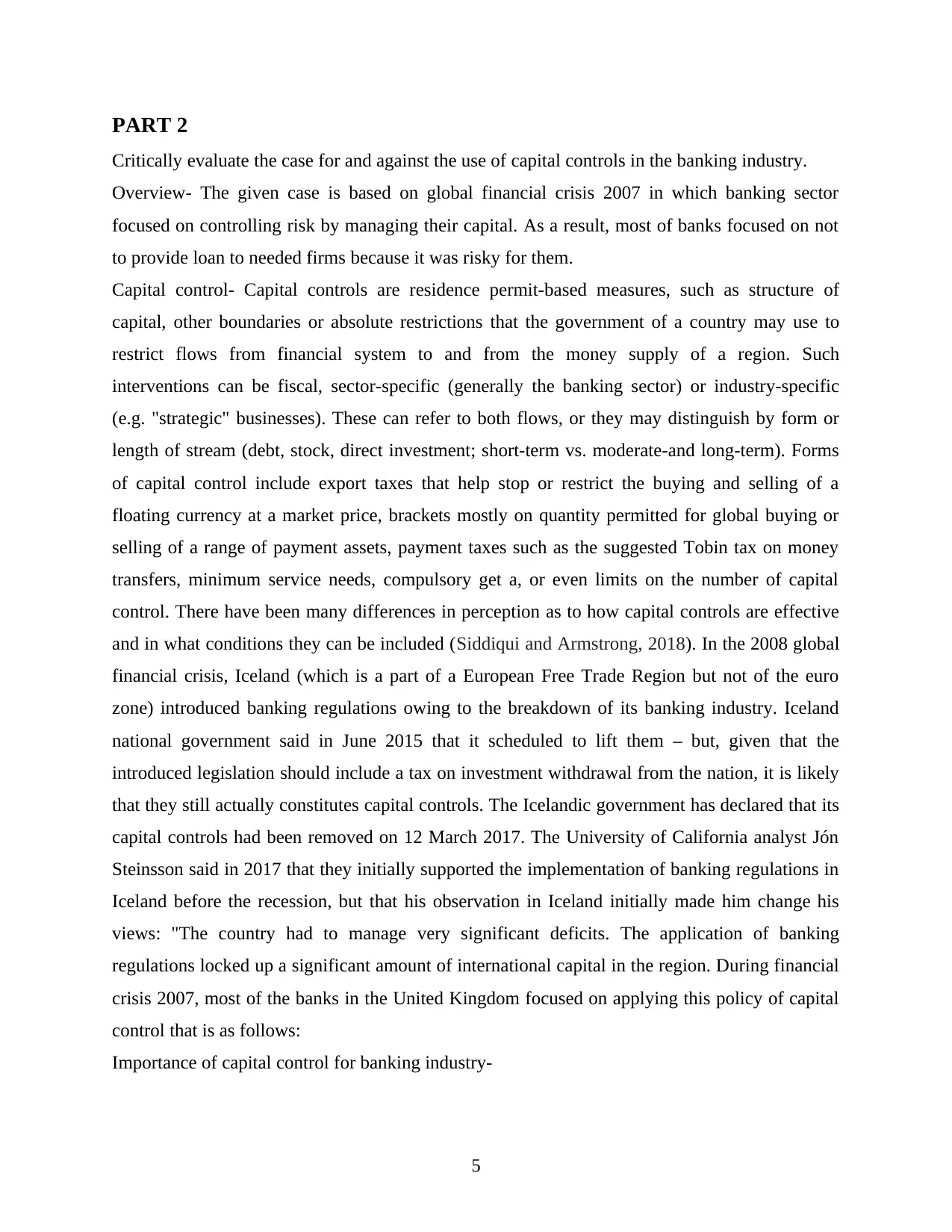
PART 2
Critically evaluate the case for and against the use of capital controls in the banking industry.
Overview- The given case is based on global financial crisis 2007 in which banking sector
focused on controlling risk by managing their capital. As a result, most of banks focused on not
to provide loan to needed firms because it was risky for them.
Capital control- Capital controls are residence permit-based measures, such as structure of
capital, other boundaries or absolute restrictions that the government of a country may use to
restrict flows from financial system to and from the money supply of a region. Such
interventions can be fiscal, sector-specific (generally the banking sector) or industry-specific
(e.g. "strategic" businesses). These can refer to both flows, or they may distinguish by form or
length of stream (debt, stock, direct investment; short-term vs. moderate-and long-term). Forms
of capital control include export taxes that help stop or restrict the buying and selling of a
floating currency at a market price, brackets mostly on quantity permitted for global buying or
selling of a range of payment assets, payment taxes such as the suggested Tobin tax on money
transfers, minimum service needs, compulsory get a, or even limits on the number of capital
control. There have been many differences in perception as to how capital controls are effective
and in what conditions they can be included (Siddiqui and Armstrong, 2018). In the 2008 global
financial crisis, Iceland (which is a part of a European Free Trade Region but not of the euro
zone) introduced banking regulations owing to the breakdown of its banking industry. Iceland
national government said in June 2015 that it scheduled to lift them – but, given that the
introduced legislation should include a tax on investment withdrawal from the nation, it is likely
that they still actually constitutes capital controls. The Icelandic government has declared that its
capital controls had been removed on 12 March 2017. The University of California analyst Jón
Steinsson said in 2017 that they initially supported the implementation of banking regulations in
Iceland before the recession, but that his observation in Iceland initially made him change his
views: "The country had to manage very significant deficits. The application of banking
regulations locked up a significant amount of international capital in the region. During financial
crisis 2007, most of the banks in the United Kingdom focused on applying this policy of capital
control that is as follows:
Importance of capital control for banking industry-
5
Critically evaluate the case for and against the use of capital controls in the banking industry.
Overview- The given case is based on global financial crisis 2007 in which banking sector
focused on controlling risk by managing their capital. As a result, most of banks focused on not
to provide loan to needed firms because it was risky for them.
Capital control- Capital controls are residence permit-based measures, such as structure of
capital, other boundaries or absolute restrictions that the government of a country may use to
restrict flows from financial system to and from the money supply of a region. Such
interventions can be fiscal, sector-specific (generally the banking sector) or industry-specific
(e.g. "strategic" businesses). These can refer to both flows, or they may distinguish by form or
length of stream (debt, stock, direct investment; short-term vs. moderate-and long-term). Forms
of capital control include export taxes that help stop or restrict the buying and selling of a
floating currency at a market price, brackets mostly on quantity permitted for global buying or
selling of a range of payment assets, payment taxes such as the suggested Tobin tax on money
transfers, minimum service needs, compulsory get a, or even limits on the number of capital
control. There have been many differences in perception as to how capital controls are effective
and in what conditions they can be included (Siddiqui and Armstrong, 2018). In the 2008 global
financial crisis, Iceland (which is a part of a European Free Trade Region but not of the euro
zone) introduced banking regulations owing to the breakdown of its banking industry. Iceland
national government said in June 2015 that it scheduled to lift them – but, given that the
introduced legislation should include a tax on investment withdrawal from the nation, it is likely
that they still actually constitutes capital controls. The Icelandic government has declared that its
capital controls had been removed on 12 March 2017. The University of California analyst Jón
Steinsson said in 2017 that they initially supported the implementation of banking regulations in
Iceland before the recession, but that his observation in Iceland initially made him change his
views: "The country had to manage very significant deficits. The application of banking
regulations locked up a significant amount of international capital in the region. During financial
crisis 2007, most of the banks in the United Kingdom focused on applying this policy of capital
control that is as follows:
Importance of capital control for banking industry-
5
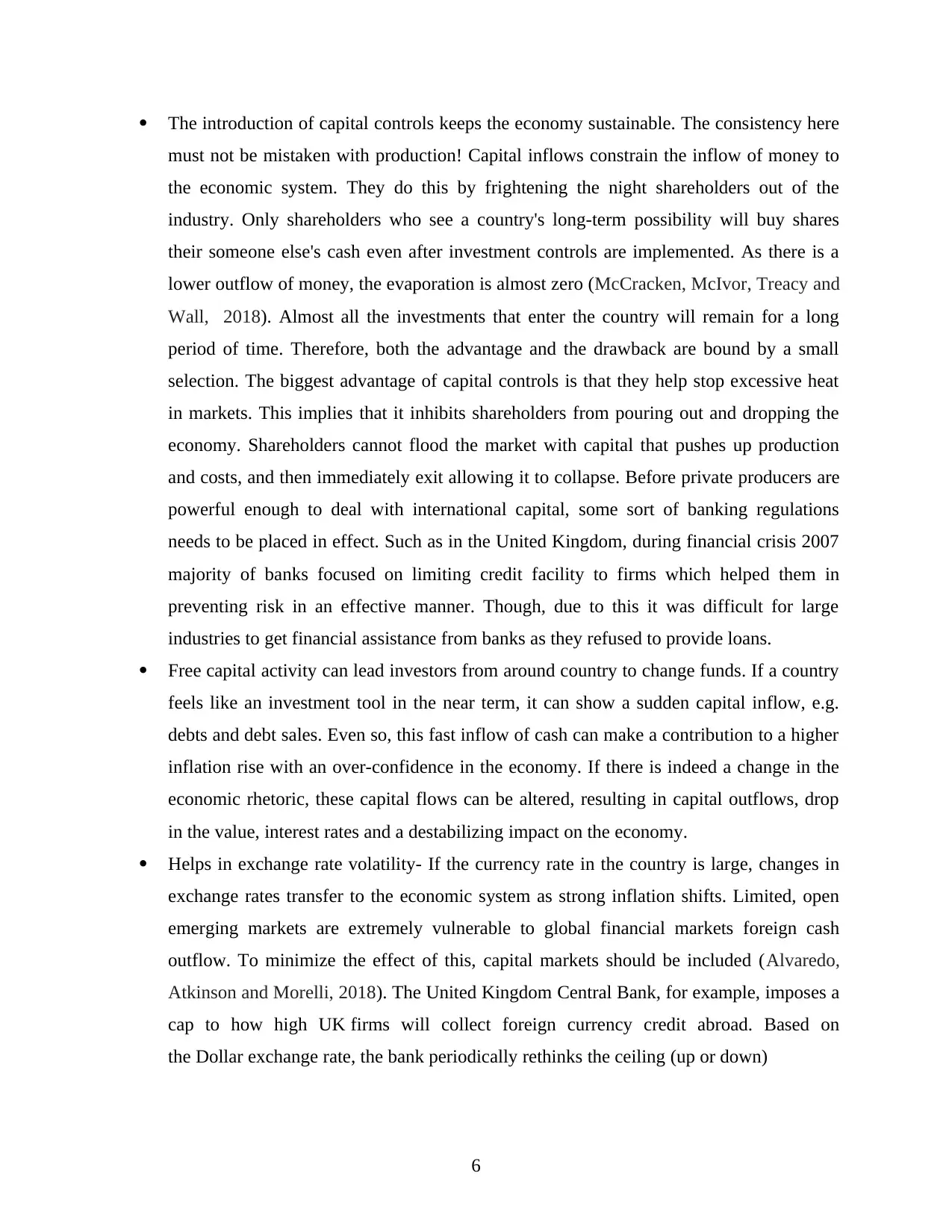
The introduction of capital controls keeps the economy sustainable. The consistency here
must not be mistaken with production! Capital inflows constrain the inflow of money to
the economic system. They do this by frightening the night shareholders out of the
industry. Only shareholders who see a country's long-term possibility will buy shares
their someone else's cash even after investment controls are implemented. As there is a
lower outflow of money, the evaporation is almost zero (McCracken, McIvor, Treacy and
Wall, 2018). Almost all the investments that enter the country will remain for a long
period of time. Therefore, both the advantage and the drawback are bound by a small
selection. The biggest advantage of capital controls is that they help stop excessive heat
in markets. This implies that it inhibits shareholders from pouring out and dropping the
economy. Shareholders cannot flood the market with capital that pushes up production
and costs, and then immediately exit allowing it to collapse. Before private producers are
powerful enough to deal with international capital, some sort of banking regulations
needs to be placed in effect. Such as in the United Kingdom, during financial crisis 2007
majority of banks focused on limiting credit facility to firms which helped them in
preventing risk in an effective manner. Though, due to this it was difficult for large
industries to get financial assistance from banks as they refused to provide loans.
Free capital activity can lead investors from around country to change funds. If a country
feels like an investment tool in the near term, it can show a sudden capital inflow, e.g.
debts and debt sales. Even so, this fast inflow of cash can make a contribution to a higher
inflation rise with an over-confidence in the economy. If there is indeed a change in the
economic rhetoric, these capital flows can be altered, resulting in capital outflows, drop
in the value, interest rates and a destabilizing impact on the economy.
Helps in exchange rate volatility- If the currency rate in the country is large, changes in
exchange rates transfer to the economic system as strong inflation shifts. Limited, open
emerging markets are extremely vulnerable to global financial markets foreign cash
outflow. To minimize the effect of this, capital markets should be included (Alvaredo,
Atkinson and Morelli, 2018). The United Kingdom Central Bank, for example, imposes a
cap to how high UK firms will collect foreign currency credit abroad. Based on
the Dollar exchange rate, the bank periodically rethinks the ceiling (up or down)
6
must not be mistaken with production! Capital inflows constrain the inflow of money to
the economic system. They do this by frightening the night shareholders out of the
industry. Only shareholders who see a country's long-term possibility will buy shares
their someone else's cash even after investment controls are implemented. As there is a
lower outflow of money, the evaporation is almost zero (McCracken, McIvor, Treacy and
Wall, 2018). Almost all the investments that enter the country will remain for a long
period of time. Therefore, both the advantage and the drawback are bound by a small
selection. The biggest advantage of capital controls is that they help stop excessive heat
in markets. This implies that it inhibits shareholders from pouring out and dropping the
economy. Shareholders cannot flood the market with capital that pushes up production
and costs, and then immediately exit allowing it to collapse. Before private producers are
powerful enough to deal with international capital, some sort of banking regulations
needs to be placed in effect. Such as in the United Kingdom, during financial crisis 2007
majority of banks focused on limiting credit facility to firms which helped them in
preventing risk in an effective manner. Though, due to this it was difficult for large
industries to get financial assistance from banks as they refused to provide loans.
Free capital activity can lead investors from around country to change funds. If a country
feels like an investment tool in the near term, it can show a sudden capital inflow, e.g.
debts and debt sales. Even so, this fast inflow of cash can make a contribution to a higher
inflation rise with an over-confidence in the economy. If there is indeed a change in the
economic rhetoric, these capital flows can be altered, resulting in capital outflows, drop
in the value, interest rates and a destabilizing impact on the economy.
Helps in exchange rate volatility- If the currency rate in the country is large, changes in
exchange rates transfer to the economic system as strong inflation shifts. Limited, open
emerging markets are extremely vulnerable to global financial markets foreign cash
outflow. To minimize the effect of this, capital markets should be included (Alvaredo,
Atkinson and Morelli, 2018). The United Kingdom Central Bank, for example, imposes a
cap to how high UK firms will collect foreign currency credit abroad. Based on
the Dollar exchange rate, the bank periodically rethinks the ceiling (up or down)
6
⊘ This is a preview!⊘
Do you want full access?
Subscribe today to unlock all pages.

Trusted by 1+ million students worldwide
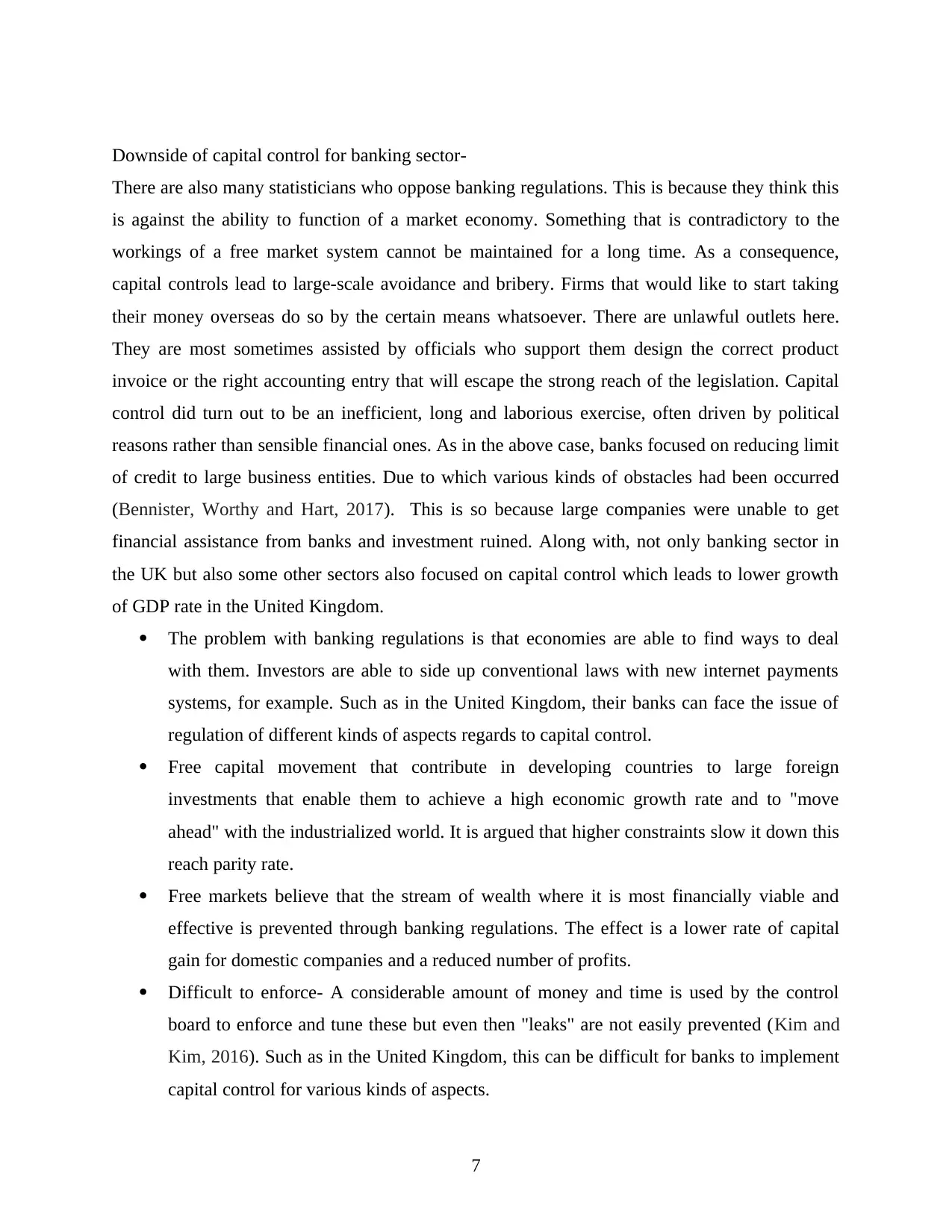
Downside of capital control for banking sector-
There are also many statisticians who oppose banking regulations. This is because they think this
is against the ability to function of a market economy. Something that is contradictory to the
workings of a free market system cannot be maintained for a long time. As a consequence,
capital controls lead to large-scale avoidance and bribery. Firms that would like to start taking
their money overseas do so by the certain means whatsoever. There are unlawful outlets here.
They are most sometimes assisted by officials who support them design the correct product
invoice or the right accounting entry that will escape the strong reach of the legislation. Capital
control did turn out to be an inefficient, long and laborious exercise, often driven by political
reasons rather than sensible financial ones. As in the above case, banks focused on reducing limit
of credit to large business entities. Due to which various kinds of obstacles had been occurred
(Bennister, Worthy and Hart, 2017). This is so because large companies were unable to get
financial assistance from banks and investment ruined. Along with, not only banking sector in
the UK but also some other sectors also focused on capital control which leads to lower growth
of GDP rate in the United Kingdom.
The problem with banking regulations is that economies are able to find ways to deal
with them. Investors are able to side up conventional laws with new internet payments
systems, for example. Such as in the United Kingdom, their banks can face the issue of
regulation of different kinds of aspects regards to capital control.
Free capital movement that contribute in developing countries to large foreign
investments that enable them to achieve a high economic growth rate and to "move
ahead" with the industrialized world. It is argued that higher constraints slow it down this
reach parity rate.
Free markets believe that the stream of wealth where it is most financially viable and
effective is prevented through banking regulations. The effect is a lower rate of capital
gain for domestic companies and a reduced number of profits.
Difficult to enforce- A considerable amount of money and time is used by the control
board to enforce and tune these but even then "leaks" are not easily prevented (Kim and
Kim, 2016). Such as in the United Kingdom, this can be difficult for banks to implement
capital control for various kinds of aspects.
7
There are also many statisticians who oppose banking regulations. This is because they think this
is against the ability to function of a market economy. Something that is contradictory to the
workings of a free market system cannot be maintained for a long time. As a consequence,
capital controls lead to large-scale avoidance and bribery. Firms that would like to start taking
their money overseas do so by the certain means whatsoever. There are unlawful outlets here.
They are most sometimes assisted by officials who support them design the correct product
invoice or the right accounting entry that will escape the strong reach of the legislation. Capital
control did turn out to be an inefficient, long and laborious exercise, often driven by political
reasons rather than sensible financial ones. As in the above case, banks focused on reducing limit
of credit to large business entities. Due to which various kinds of obstacles had been occurred
(Bennister, Worthy and Hart, 2017). This is so because large companies were unable to get
financial assistance from banks and investment ruined. Along with, not only banking sector in
the UK but also some other sectors also focused on capital control which leads to lower growth
of GDP rate in the United Kingdom.
The problem with banking regulations is that economies are able to find ways to deal
with them. Investors are able to side up conventional laws with new internet payments
systems, for example. Such as in the United Kingdom, their banks can face the issue of
regulation of different kinds of aspects regards to capital control.
Free capital movement that contribute in developing countries to large foreign
investments that enable them to achieve a high economic growth rate and to "move
ahead" with the industrialized world. It is argued that higher constraints slow it down this
reach parity rate.
Free markets believe that the stream of wealth where it is most financially viable and
effective is prevented through banking regulations. The effect is a lower rate of capital
gain for domestic companies and a reduced number of profits.
Difficult to enforce- A considerable amount of money and time is used by the control
board to enforce and tune these but even then "leaks" are not easily prevented (Kim and
Kim, 2016). Such as in the United Kingdom, this can be difficult for banks to implement
capital control for various kinds of aspects.
7
Paraphrase This Document
Need a fresh take? Get an instant paraphrase of this document with our AI Paraphraser
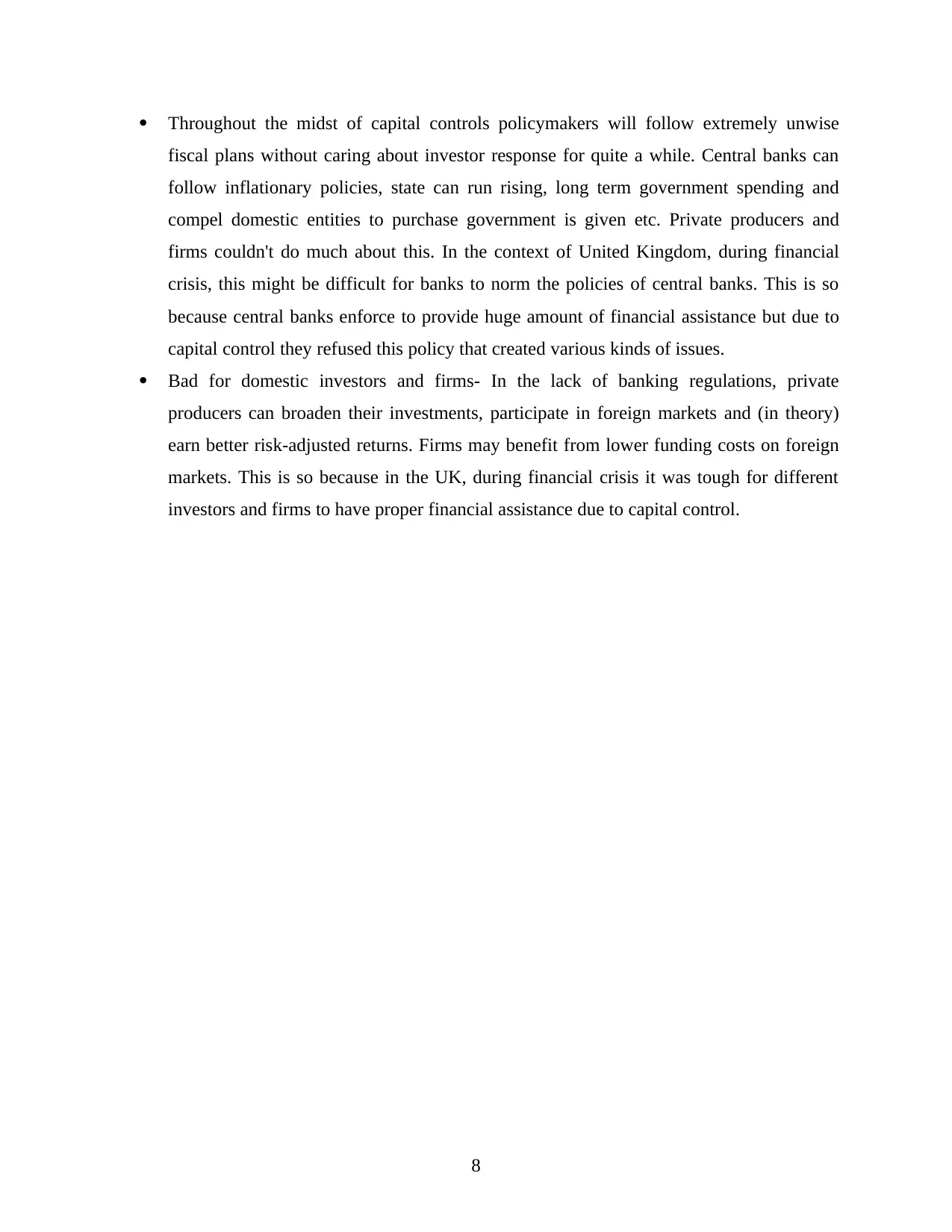
Throughout the midst of capital controls policymakers will follow extremely unwise
fiscal plans without caring about investor response for quite a while. Central banks can
follow inflationary policies, state can run rising, long term government spending and
compel domestic entities to purchase government is given etc. Private producers and
firms couldn't do much about this. In the context of United Kingdom, during financial
crisis, this might be difficult for banks to norm the policies of central banks. This is so
because central banks enforce to provide huge amount of financial assistance but due to
capital control they refused this policy that created various kinds of issues.
Bad for domestic investors and firms- In the lack of banking regulations, private
producers can broaden their investments, participate in foreign markets and (in theory)
earn better risk-adjusted returns. Firms may benefit from lower funding costs on foreign
markets. This is so because in the UK, during financial crisis it was tough for different
investors and firms to have proper financial assistance due to capital control.
8
fiscal plans without caring about investor response for quite a while. Central banks can
follow inflationary policies, state can run rising, long term government spending and
compel domestic entities to purchase government is given etc. Private producers and
firms couldn't do much about this. In the context of United Kingdom, during financial
crisis, this might be difficult for banks to norm the policies of central banks. This is so
because central banks enforce to provide huge amount of financial assistance but due to
capital control they refused this policy that created various kinds of issues.
Bad for domestic investors and firms- In the lack of banking regulations, private
producers can broaden their investments, participate in foreign markets and (in theory)
earn better risk-adjusted returns. Firms may benefit from lower funding costs on foreign
markets. This is so because in the UK, during financial crisis it was tough for different
investors and firms to have proper financial assistance due to capital control.
8
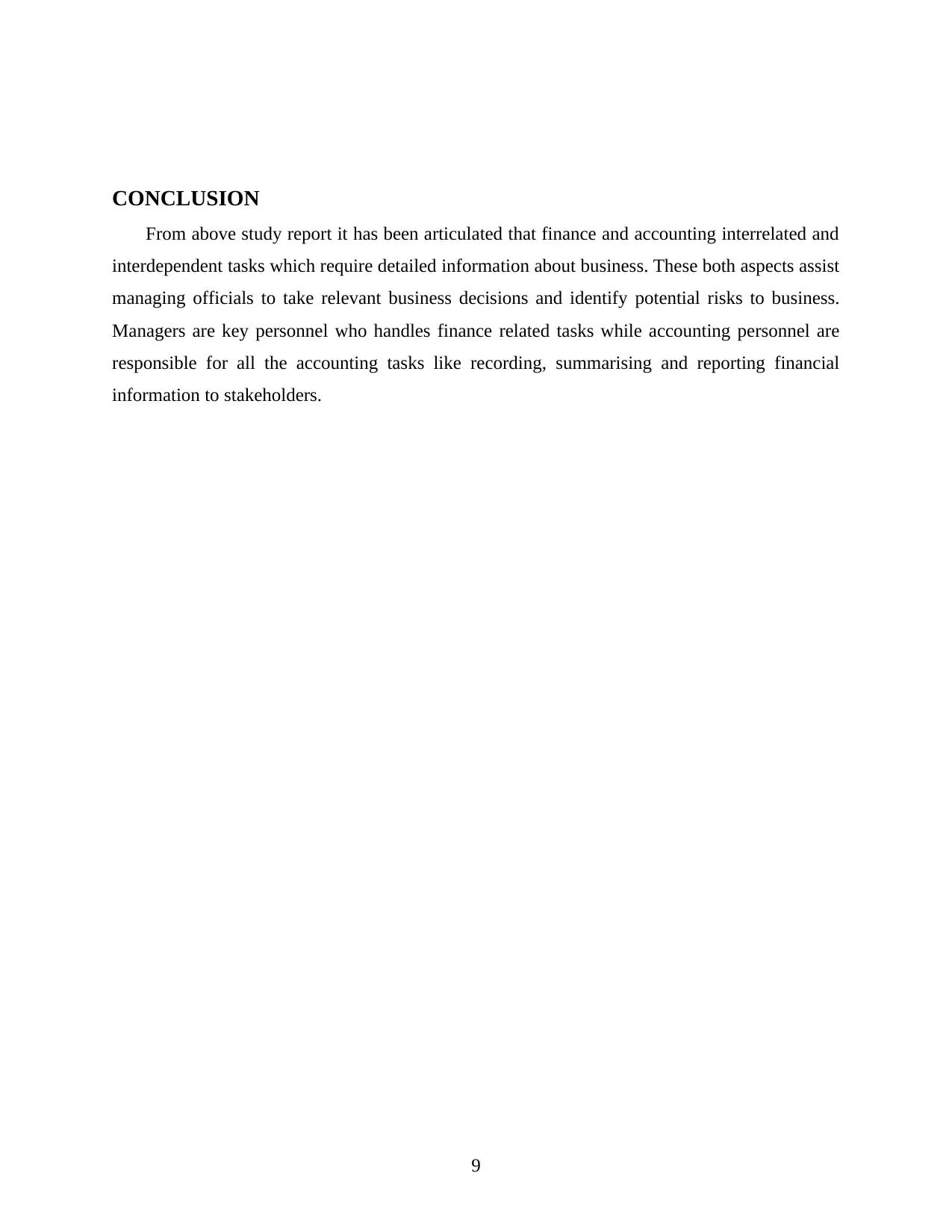
CONCLUSION
From above study report it has been articulated that finance and accounting interrelated and
interdependent tasks which require detailed information about business. These both aspects assist
managing officials to take relevant business decisions and identify potential risks to business.
Managers are key personnel who handles finance related tasks while accounting personnel are
responsible for all the accounting tasks like recording, summarising and reporting financial
information to stakeholders.
9
From above study report it has been articulated that finance and accounting interrelated and
interdependent tasks which require detailed information about business. These both aspects assist
managing officials to take relevant business decisions and identify potential risks to business.
Managers are key personnel who handles finance related tasks while accounting personnel are
responsible for all the accounting tasks like recording, summarising and reporting financial
information to stakeholders.
9
⊘ This is a preview!⊘
Do you want full access?
Subscribe today to unlock all pages.

Trusted by 1+ million students worldwide
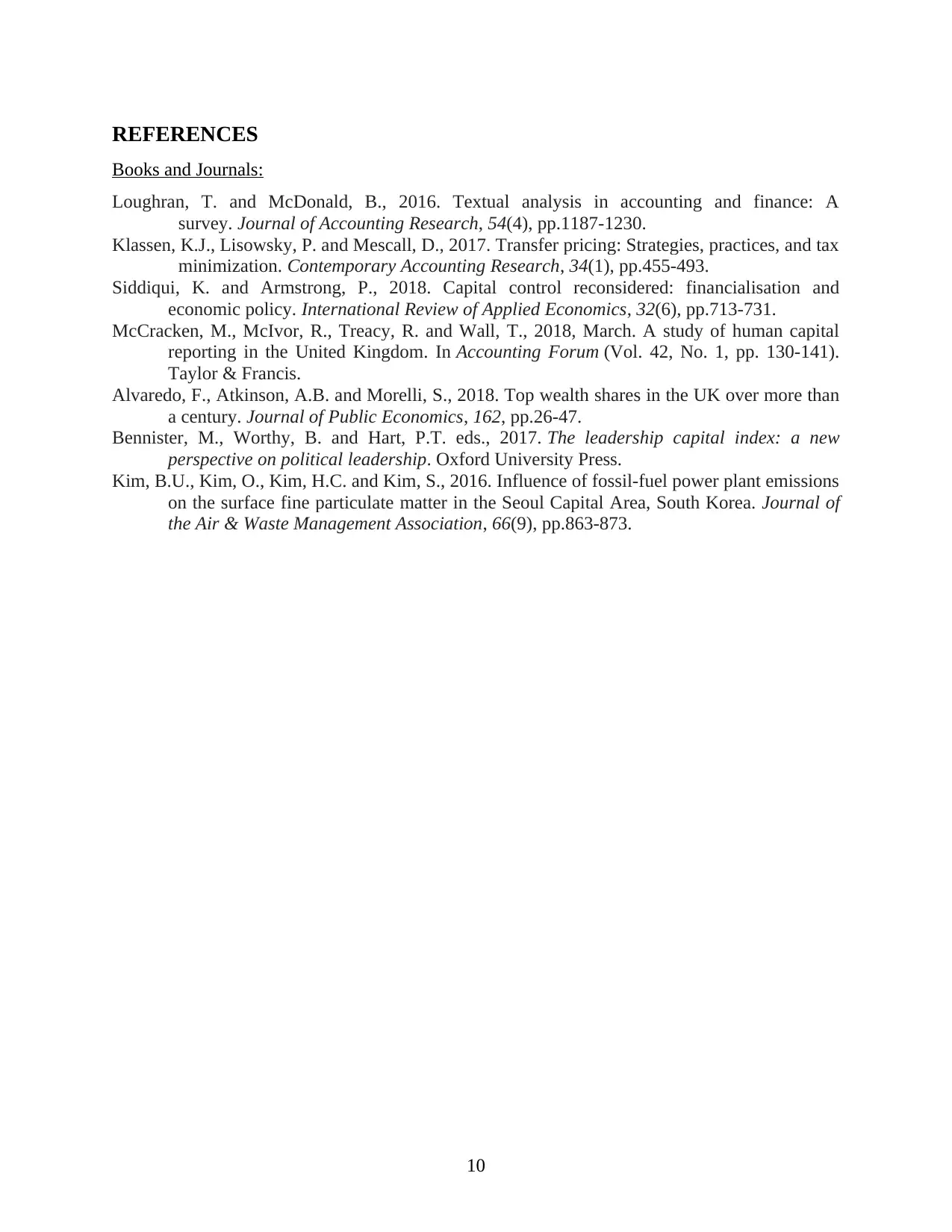
REFERENCES
Books and Journals:
Loughran, T. and McDonald, B., 2016. Textual analysis in accounting and finance: A
survey. Journal of Accounting Research, 54(4), pp.1187-1230.
Klassen, K.J., Lisowsky, P. and Mescall, D., 2017. Transfer pricing: Strategies, practices, and tax
minimization. Contemporary Accounting Research, 34(1), pp.455-493.
Siddiqui, K. and Armstrong, P., 2018. Capital control reconsidered: financialisation and
economic policy. International Review of Applied Economics, 32(6), pp.713-731.
McCracken, M., McIvor, R., Treacy, R. and Wall, T., 2018, March. A study of human capital
reporting in the United Kingdom. In Accounting Forum (Vol. 42, No. 1, pp. 130-141).
Taylor & Francis.
Alvaredo, F., Atkinson, A.B. and Morelli, S., 2018. Top wealth shares in the UK over more than
a century. Journal of Public Economics, 162, pp.26-47.
Bennister, M., Worthy, B. and Hart, P.T. eds., 2017. The leadership capital index: a new
perspective on political leadership. Oxford University Press.
Kim, B.U., Kim, O., Kim, H.C. and Kim, S., 2016. Influence of fossil-fuel power plant emissions
on the surface fine particulate matter in the Seoul Capital Area, South Korea. Journal of
the Air & Waste Management Association, 66(9), pp.863-873.
10
Books and Journals:
Loughran, T. and McDonald, B., 2016. Textual analysis in accounting and finance: A
survey. Journal of Accounting Research, 54(4), pp.1187-1230.
Klassen, K.J., Lisowsky, P. and Mescall, D., 2017. Transfer pricing: Strategies, practices, and tax
minimization. Contemporary Accounting Research, 34(1), pp.455-493.
Siddiqui, K. and Armstrong, P., 2018. Capital control reconsidered: financialisation and
economic policy. International Review of Applied Economics, 32(6), pp.713-731.
McCracken, M., McIvor, R., Treacy, R. and Wall, T., 2018, March. A study of human capital
reporting in the United Kingdom. In Accounting Forum (Vol. 42, No. 1, pp. 130-141).
Taylor & Francis.
Alvaredo, F., Atkinson, A.B. and Morelli, S., 2018. Top wealth shares in the UK over more than
a century. Journal of Public Economics, 162, pp.26-47.
Bennister, M., Worthy, B. and Hart, P.T. eds., 2017. The leadership capital index: a new
perspective on political leadership. Oxford University Press.
Kim, B.U., Kim, O., Kim, H.C. and Kim, S., 2016. Influence of fossil-fuel power plant emissions
on the surface fine particulate matter in the Seoul Capital Area, South Korea. Journal of
the Air & Waste Management Association, 66(9), pp.863-873.
10
1 out of 10
Related Documents
Your All-in-One AI-Powered Toolkit for Academic Success.
+13062052269
info@desklib.com
Available 24*7 on WhatsApp / Email
![[object Object]](/_next/static/media/star-bottom.7253800d.svg)
Unlock your academic potential
Copyright © 2020–2025 A2Z Services. All Rights Reserved. Developed and managed by ZUCOL.




